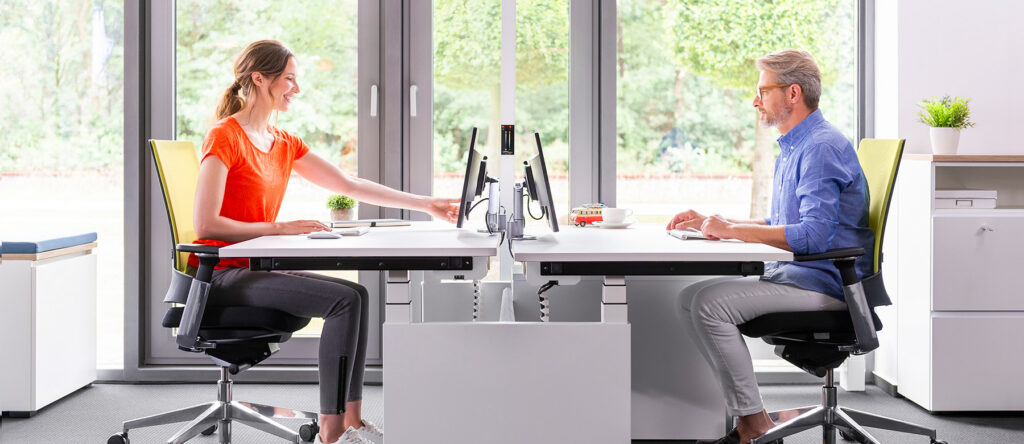Everything you need to know about this approach
Surveys show that many employees are pleased that working from home is becoming more acceptable, but most of you wouldn’t want to work from home every day. That’s why more and more companies are using desk-sharing concepts, which are also helpful in terms of hygiene protection measures: employees’ schedules are arranged in such a way that fewer people are in the office at the same time, reducing the risk of infection. The employees who aren’t at the office work from home. Desk-sharing combines the positive aspects of home office use, such as not having to commute, with the pleasant sides of working in the office, such as interacting with colleagues. We show you what else desk-sharing has to offer and what’s important if you want it to be effective.
Desk-sharing and its benefits create a happier workforce
The desk-sharing concept is used when an office building has more staff than workstations: two or more employees come into the office at different times and use the same desk, making optimal use of the available resources. The concept has advantages both for the company and for its employees: Employers save office space and equipment costs thanks to shared workstations, and benefit from the increased productivity of their staff. Employees feel less stuck in routine because their environment varies, and they can work more flexibly during their home office hours, improving their work-life balance. And the concept is sound: the benefits, including higher levels of employee satisfaction, have been confirmed by a survey carried out by the Fraunhofer Institute for Industrial Engineering.
One of the biggest advantages of the desk-sharing concept is the increase in employee satisfaction. What makes this possible is the space gained due to fewer desks cluttering up the office. Additional areas such as meeting points or creativity zones make the working day less monotonous and foster teamwork, and thanks to modern, flexible office furnishings, employees enjoy coming to work. The concept also promotes a better work-life balance, allowing employees to flexibly combine their job and their family or leisure time.
Implementing a desk-sharing concept: these five points are crucial
Desk-sharing sounds great, but the implementation has to be properly thought out. The following tips will make working under a desk-sharing arrangement easier for you.
-
How do I adapt my workstation to my personal needs?
If you share your – ideally height-adjustable – desk with other colleagues, the right equipment will help you quickly adapt the workstation to your needs. Flexible and functional equipment includes e.g. an adjustable office chair, desk and ergonomically adjustable screens. A movable support arm will make setting the height and angle of your screen especially fast and easy – simply pull the screen into the right position and you’re ready to start!
-
How do I keep my desk tidy?
You and your fellow desk user are working on different tasks. Functional tray and organisation systems will help you quickly and neatly order your documents and always keep track of everything, allowing you to perform your tasks more quickly – and feel a sense of achievement more frequently. A nice and tidy-looking desk will increase your satisfaction.
-
How do my colleagues and I manage attendance?
The main question when you share a desk is “who is here when?”. To prevent two colleagues arriving at the same desk at once, you can create an attendance plan. Place a grid on a whiteboard with the names of your colleagues and the days of the week; you can simply mark attendance with a coloured magnet (and, if applicable, a slip of paper with the time, if attendance is split e.g. between morning and afternoon slots). Make sure to create a legend and note which colour represents which colleague.
-
How do I adjust the light to my needs?
Different jobs demand different lighting conditions. Working concentratedly in the morning requires bright, strong light, whereas for tasks that demand less concentration, more muted light is sufficient. Rotatable, flexible lamps with adequate light output and perhaps an automatic brightness adjustment provide optimal illumination for your workstation. If you choose a combination of floor and desk lamp, you can adapt the light even better to the individual needs of each employee and the natural daylight.
-
How do I create the ideal workstation in my home office?
